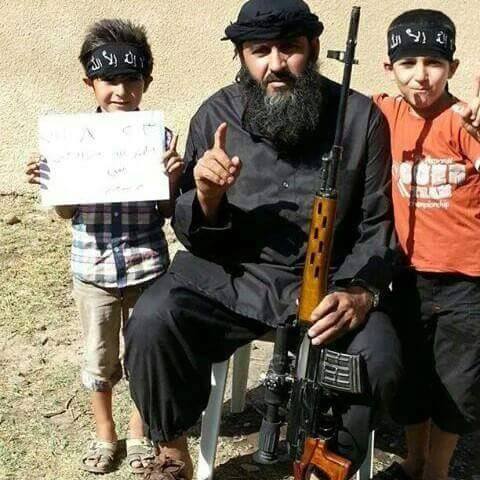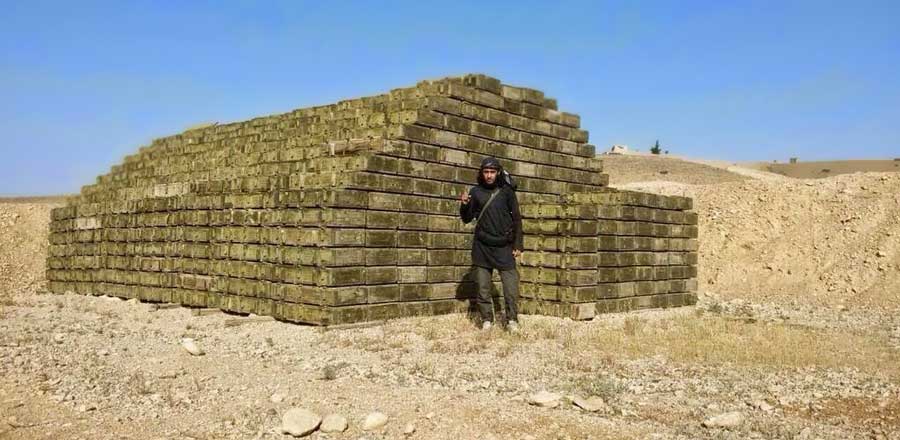- Home
- مقالات
- English
The Assad Army – the Main Ammunition and Arms Supplier to ISIS
The costs of one transaction made by the organization amounted to 80 million dollars
Special Report
Despite its battles on several fronts over the past two years, during which it has distinguished itself as a main force on the map of struggle in Syria, ISIS organization generally hasn't suffered from a shortage of arms or ammunition, which can be attributed to the spoils it has taken in the battles it has won , and to its enormous financial resources that have made it the favorite customer of arms dealers.
Ordnance Offices
Ordnance offices are counted as part of the military bodies in each " wilaya " (province), and they are under the control of the military emirs of the wilayas . These offices have been allowed a certain degree of freedom and independence in running their business, with a high degree of cooperation among them, particularly in emergency situations when a certain ordnance office can't procure the needs of its wilaya . The main functions of these offices are as follows:
1-Procuring a constant supply of ammunition that can cover the needs of the wilaya army, which can be done through buying it from licensed dealers.
2-collecting the ammunition and arms spoils the organization takes during its battles and making an inventory of them, then distributing a fifth of the estimated financial value of these spoils among the fighters who participated in the battle.
3-Supplying fighters with ammunition during battles through ammunition-supplier battalions included in the divisions that constitute the wilaya army.
After August 2015, there appeared new organization of the work of ISIS ordnance apparatus. The ordnance offices in the Syrian wilayas were attached to a central office in ar-Raqqa, which started to undertake the responsibility of part of the work of branch offices, which were now prohibited from directly doing business with dealers, and transactions with them were confined to the main office. The reasons for this change remain unknown, but the varying purchase prices that each wilaya offers, and the fact that some dealers prefer to do business with certain wilayas may be the explanation for this change.

Ghazi al- Haj Hassan
The central ordnance office of ISIS in Syria is headed by Ghazi al- Haj Hassan, nicknamed abu al-Hassan Barah- after his village, al-Barah, located in Jabal al-Zawiya in Idlib province. Abu al-Hassan is about 40 years old. Before the uprising, he was a school teacher, and he was detained for a short time for having CD-ROMs that contain sermons delivered by a(salafi)Imam. After the outbreak of the uprising, he engaged in the military action and joined the "Regiments of Syria's Martyrs" under the leadership of Jamal Maarouf. Later, he joined the ranks of al-Nusra Front and dedicated himself to smuggling " al-Muhajireen"( emigrants) across the border into Syria, then he joined the(Islamic State in Iraq and the Levent) as soon as it had been declared in April 2013.
Between Syria and Iraq
In the summer of 2014, when ISIS won many victories, ammunition and arms shipments started to move in one direction- from Syria to Iraq- despite the enormous quantities the organization seized from the depots of the Iraqi army near Mosul. Ammunition and arms prices in Syria have always remained less than they have been in Iraq, which can be explained by ISIS ability to establish an effective ammunition supply network for which the depots of the Assad forces have been the main source through two ways:
1-The Spoils of War
The arms and ammunition quantities taken from the Free Army and the other factions by ISIS appear to be an occasional source –despite its importance- compared to the spoils ISIS has taken in its successive battles against the Assad forces, especially in Division 17, Brigade 93, the Tabaqa airport in ar-Raqqa, Fawj 121 in al-Hasaka, the arms depots in Palmyra, and part of the arms depots in Deir ez-Zour. It is difficult to give a verdict on some battles against the Assad forces that ISIS won easily and in a short time; some of these victories suggest that the regime intentionally gave up large quantities of ammunition and weapons to ISIS so that the latter could launch more assaults, and expand at the expense of the revolutionary forces. The sudden and ignominious defeat that ISIS inflicted on the Assad forces in Palmyra last May is counted as the most obvious example of the suspicious clashes between the two sides, which led, among other things, to ISIS seizing enormous quantities of ammunition that were more than it needed at the time, whereupon ordnance offices stopped temporarily the processes of purchase, and postponed the orders for ammunition and arms for 3 months, despite having made deals with traders before.
2-Purchase Processes
In addition to the spoils, the processes of direct purchase are considered to be a main source of ISIS arms and ammunition. Disregarding the ammunition shipments coming through smugglers from the liberated areas in Aleppo and Idlib, as they are negligible, we can say that the shipments coming from the units of the Syrian army appear to be the most important source for the organization depots. Despite the open battles between the two sides, some of the regime high-ranking officers have not stopped selling quantities of ammunition to dealers known to be working for ISIS, especially in the military formations on the eastern edges of as-Suwayda province, and on the periphery of the towns and cities of eastern Qalamoun. The same applies to some formations in Homs province and Damascus countryside province, from which the shipments are transported across Badiat ash-Sham to ar-Raqqa and Deir ez-Zour, and then to the other ISIS wilayas in Syria and Iraq.
ISIS and Arms Dealers
The organization doesn't impose a vow of allegiance on arms dealers who apply for a trade license, but it lays down a condition on them that it must be the sole purchaser of all their goods. Otherwise, they would be sentenced to death. A dealer is allowed to sell another dealer- who is usually richer- under the condition that the final purchaser be one of ISIS ordnance offices. Dealers are also allowed to establish relationships with brokers, figures of authority, and army officers so that business transactions can be safely made. Of course, dealers are allowed freedom of movement from ISIS- controlled areas to the regime- controlled areas or vice versa. Favoritism and personal recommendations play a major role in the rise of a certain dealer; influential security and military officials have the final say in preferring one offer to another in the major and frequent transactions that the central ordnance office-and previously, the ordnance offices of the wilayas - intends to make. In Deir ez-Zour province" wilayat al-Kair" , the strong relationship- or maybe the secret partnership- between the dealer(S. H. M) , from al- Mayadeen city, and a brother of a prominent sharia man's (A. A. N. ) had an important role in choosing that dealer and making several transactions between the two sides, which was a factor that contributed to increasing his capital and his making useful business contacts in ISIS high command, whereupon he became one of the ten largest dealers who work for ISIS.
Estimate of Expenditure
In order to arrive at approximate figures concerning ISIS consumption of ammunition, one has to calculate the ammunition that one single fighter requires during a single day of combat of average intensity. According to the usual armament of ISIS fighters during battle, the ammunition that a rifle-armed fighter is issued with (300 cartridges: 150 ones in the cartridge belt and another 150 ones in magazines) is equal to the ammunition that an infantryman in a professional army is issued with. The ammunition that machine gun shooters, RPG shooters, and snipers carry is almost equal to what their counterparts in professional armies carry. When the organization launches an assault that lasts 3 days on a major target such as Deir ez-Zour military airport with the participation of 500 infantrymen, we can determine ISIS consumption of and expenditure on ammunition in that assault according to what the table below shows:
According to the table that has been prepared on the basis of estimates that are close to reality and according to the prices of ammunition in late 2015, the total cost of the ammunition that infantrymen require is about $ 970,000. It is difficult to estimate the cost of the ammunition for heavy weapons such as tanks, pieces of artillery, and things like that. Yet, taking a look at the prices of this class of weapon helps us to have a complete conception of ISIS expenditure on ammunition; the average price of a tank shell is $ 1300, and the price of a 23-mm heavy gun shell is $10, while the price of a Konkurs anti-tank missile is $16,000.
| Type of weapon | Number of fighters | The quantity consumed in one day of combat (cartridge) | The quantity consumed in 3 days | The price of one cartridge (American dollar) | Total costs (American dollar) |
| Rifle | 340 | 300 | 306000 | 0,9 | 275400 |
| BKS gun | 92 | 500 | 138000 | 0,9 | 124200 |
| Sniper rifle | 14 | 75 | 3150 | 1 | 3150 |
| RPG | 54 | 7 | 1134 | 500 | 567000 |
In addition to favoritism and recommendations, the success of one dealer in fulfilling ISIS needs for a special type of weapon may cause him to rise in prominence, and to be chosen as a possible dealer that can procure some special and large orders. A remarkable example of such a dealer is (A. T.Sh.), who succeeded in procuring shipments of TNT, or what is called- in dealers language- quartz, which is a substance that the organization needs badly, as it is used in booby-trappings and explosions. The shipments consisted of 40,000 rolls, which the organization bought for more than $80 million.
- Translated by Fayez Masri
- This report appeared in issue 67


 Fayez Masri
Fayez Masri



